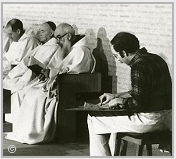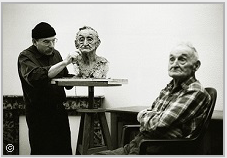

Return to the Home Page
Stanley Roseman - An Artist's Journal
Stanley Roseman - An Artist's Journal
BIOGRAPHY
''STANLEY ROSEMAN combines an innate artistic talent, expressed through a wide range of techniques, with a profound interest in the human condition in portraying different kinds of people, professions, social or artistic groups. With a seriousness that pushes him always further in treating a subject or theme, he continually clarifies and refines, never letting his interest waiver or diminish.''[1]
''The moments Roseman has captured are many and varied,'' writes The Saratogian, Saratoga, New York, ''and a walk through the exhibition is a trip through what will be our cultural heritage.''
The Performing Arts in America exhibition concluded its national tour at the Library and Museum for the Performing Arts, Lincoln Center, New York City, winter-spring, 1977. Lincoln Center announced the exhibition with a large banner displayed in Lincoln Center Plaza. The Library and Museum published a special limited edition, silk screen exhibition poster which featured Roseman's drawing of the renowned American actor Morris Carnovsky in his acclaimed role as King Lear at the American Shakespeare Festival, 1975.
- Bibliothèque Nationale de France
Roseman's work has received wide critical acclaim, including laudatory reviews in The New York Times and The Times, London, and is represented in important museums and private collections.
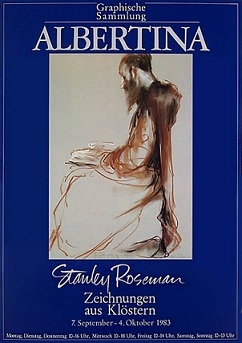
Diversity of Subjects
From the outset of his career in New York City in the 1970's, Roseman was interested in different subjects for his work. The artist's paintings and drawings from that period include portraits; an extensive work on the performing arts, which the artist created in theatres, opera houses and at the circus; depictions of the male and female nude, as well as still lifes; animal companions, such as his Abyssinian cat; and landscapes in the Berkshires in western Massachusetts, a region the artist first knew from summers in his youth.
The exciting world of the performing arts is a major theme in Roseman's oeuvre. With invitations from leading opera, theatre, and dance companies, Roseman drew at dress rehearsals and performances from the front of the auditorium and the wings of the stage renowned singers, actors, and dancers as well as supporting players and members of the chorus and the corps de ballet in a spectrum of memorable cultural events of the time.
The American Bicentennial exhibition Stanley Roseman - The Performing Arts in America
With an equally cordial invitation from the Ringling Bros. and Barnum & Bailey Circus, Roseman was brought into the closed and itinerant circus community where he drew and painted portraits of the celebrated clowns.
The exhibition, produced by Ronald Davis, opened on the eve of the American bicentennial celebrations in December 1975 in the historic city of Philadelphia, where the Declaration of Independence was adopted by the Continental Congress on July 4, 1776. The Curtis Institute of Music, one of the world's leading music conservatories, presented the exhibition in Philadelphia, and thereafter the exhibition toured the United States through 1976.
The artist's paintings and drawings on the performing arts comprised the American Bicentennial exhibition Stanley Roseman - The Performing Arts in America.
3. Lincoln Center, New York City
Lincoln Center Plaza
with the banner announcing the exhibition
Stanley Roseman - The Performing Arts in America,
Library and Museum for the Performing Arts, 1977.
In the photograph above is seen the multi-arched edifice
of the Metropolitan Opera House.
Lincoln Center Plaza
with the banner announcing the exhibition
Stanley Roseman - The Performing Arts in America,
Library and Museum for the Performing Arts, 1977.
In the photograph above is seen the multi-arched edifice
of the Metropolitan Opera House.
Education at Home and Travels Abroad
Roseman earned a Bachelor of Fine Arts degree from the prestigious Cooper Union for the Advancement of Science and Art, in New York City, and his Master of Fine Arts degree from the equally respected Pratt Institute, also in New York City. Pursuing his career in the early 1970's, Roseman went his own way counter to the dominant art movements that negated the presence of the human figure and Nature.
Roseman's interest in the nomadic Saami as a subject for his work took him and his colleague Ronald Davis in 1976 beyond the Arctic Circle to the windswept tundra of Norwegian Lappland. There, in the rural township of Kautokeino, the artist painted life-size portraits of the Saami, an independent, reindeer-herding people who maintain their centuries-old, nomadic way of life in one of the earth's harshest environments.
The Saami People of Lappland
5. Bier An'te (detail), 1976
Reindeer Herder,
Lappland
Oil on canvas, 98 x 80 cm
Collection of the artist
Reindeer Herder,
Lappland
Oil on canvas, 98 x 80 cm
Collection of the artist
© Stanley Roseman and Ronald Davis, 2014 - All Rights Reserved
Visual imagery and website content may not be reproduced in any form whatsoever.
Visual imagery and website content may not be reproduced in any form whatsoever.
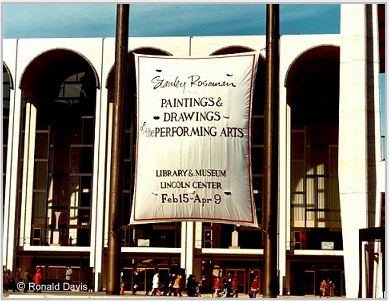
Dr. Walter Koschatzky, Director of the Albertina, made his first acquisition in November 1978 of Roseman's drawings from his travels to European monasteries, a work the artist began in the spring of that year. In a cordial letter the eminent Director writes to Roseman's colleague Ronald Davis:
"You have delivered to me two drawings by Stanley Roseman, which I have acquired for the Albertina. I thank you and want to express my conviction that the artist is an outstanding draughtsman and painter to whom much recognition and success are due.''
Recognized as a master draughtsman, Roseman was honored in 1983 as the first American artist to have a one-man exhibition at the Graphische Sammlung Albertina, Vienna's renowned museum housing one of the world's greatest collections of master drawings. The Albertina presented the exhibition Stanley Roseman-Zeichnungen aus Klöstern (Drawings from the Monasteries).
- Dr. Walter Koschatzky, Director
Graphische Sammlung Albertina
Graphische Sammlung Albertina
2. Albertina poster featuring Roseman's drawing Brother Thijs in the Library, 1982, St. Adelbert Abbey, the Netherlands.
The drawing is in the collection of the Albertina, Vienna.
The drawing is in the collection of the Albertina, Vienna.
Spirit of the Clown

NBC Television News on its evening broadcast announced The Performing Arts in America exhibition at Lincoln Center and aired an enthusiastic reportage of Roseman at the Ringling Bros. and Barnum & Bailey Circus at New York City's famed coliseum Madison Square Garden.
NBC Television states: "The clowns of the Garden have invited Stan into their backstage lives as a friend. He has joined the circus family." The news broadcast included an interview with the artist in the Main Gallery of the Lincoln Center Museum, where were exhibited some one-hundred drawings on opera, theatre, and dance and a series of paintings of the clowns. NBC Television enthused: "These are clown portraits that look behind the greasepaint."
Roseman received a superlative review in The New York Times for his paintings of the circus clowns. The review titled "Spirit of the Clown" features the splendid portrait of the Ringling Bros. and Barnum & Bailey Circus clown Keith Crary, presented here, (fig. 4). The review is subtitled:
"Paintings by Stanley Roseman glow with a shiny dignity."
- The New York Times
Roseman's work on the subject of the circus clown includes "a superb portrait sculpture in bronze of King Richard'' and "a magnificent portrait of the young clown Charlie" (Anzeiger von Saanen, Gstaad); as well as "a stunning series of engravings entitled 'Clowns' '' (The Times, London).
4. Keith Crary (detail), 1973
Oil on canvas
Collection of the artist
Oil on canvas
Collection of the artist
The portrait is seen here
as featured in
The New York Times review
"Spirit of the Clown."
as featured in
The New York Times review
"Spirit of the Clown."
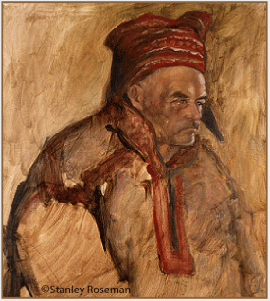
The following year the Peabody Museum, Yale University, presented the portraits in an "excellent exhibit,'' praises The Morning Record & Journal, Meriden, Connecticut. In its review "Art and Anthropology at the Peabody,'' the Connecticut daily states: "Together with background photographs and displayed artifacts, the room is literally overflowing with the Saami culture. Detail in the portraits is concentrated in the faces and sometimes the hands. These are opaquely painted in full modeling, each strong, expressive and individual.''
Aftonbladet, Stockholm, published a cover story on Roseman in the paper's Sunday magazine and commends him for painting portraits "on a high artistic level as well as accurately expressive of the human dimension." The leading Swedish daily writes of the Saami paintings: "They give an overwhelming sense of individuality and humanity," exemplified by the portrait Bier An'te, Reindeer Herder, 1976, (fig. 5).
The Monastic Life
The Parisian daily La Croix writes in an enthusiastic reportage in 1980 on the work of Stanley Roseman:
''When I began researching and planning my work on the monastic life," writes Roseman, "my thoughts were towards Europe for monastic life is interwoven with the history and culture of Europe."
Roseman embarked in 1978 on what the Los Angeles Times calls ''a sweeping artistic project.'' The artist was invited to live in Benedictine, Cistercian, Trappist, and Carthusian monasteries and to share in the day-to-day life in the cloister.
"He found again in the hospitality of the monasteries what he found in the Saami camps and under the circus tents. Is there not a profound relationship between the migrations of nomads, the voyages of traveling players, and the inner journey which is the contemplative life."
- La Croix, Paris
8. Padre Valeriano,
Portrait of a Trappist Monk
in Prayer, 1998
San Pedro de Cardeña, Spain
Chalks on paper, 50 x 35 cm
Victoria and Albert Museum, London
Portrait of a Trappist Monk
in Prayer, 1998
San Pedro de Cardeña, Spain
Chalks on paper, 50 x 35 cm
Victoria and Albert Museum, London
When Roseman began painting and drawing in monasteries in the 1970's, monastic life was little known to the general public and an unfamiliar subject for a modern artist's work. Monastic life was rarely a topic for coverage in the popular press. Unlike today, monasteries then were closed to television cameras and documentary filmmakers, and the Internet, with its vast information resources, did not exist. Roseman's work on the monastic life brought a new awareness of the centuries-old and far-reaching contemplative tradition in Western culture.
- ARA arte religioso actual, Madrid
The respected art journal ARA arte religioso actual, Madrid, published in the fall of 1979 a laudatory reportage entitled ''Stanley Roseman y la Vida Monastica'' and states:
Roseman created a monumental and critically acclaimed oeuvre on the monastic life - a life centered on contemplation and prayer in observing the Biblical call: "At midnight I rise to praise you, O Lord," and "Seven times a day I praise you," stated by the Prophet in the Book of Psalms.
From Roseman's first sojourn in a monastery, in April 1978, the breadth and geographical scope of his work over the following months and years took the artist from England and Ireland across the Continent to Eastern Europe and from Sweden, during the season of the midnight sun, to Spain at Christmas.
At the Abbey of San Pedro de Cardeña, in Castile, in November-December 1998, Roseman drew the impressive work Padre Valeriano, Portrait of a Trappist Monk in Prayer, (fig. 8), collection of the Victoria and Albert Museum, London.
The year 1998 commemorated the 900th anniversary of the founding of the Cistercian Order that dates from 1098. Cistercian monasticism today comprises two branches: Order of Cistercians of the Common Observance and Order of Cistercians of the Strict Observance, or Trappist Order.
''The pictures - splendid and telling all at once - form the stimulating vanguard towards so original and deep a study of the monastic life.''
Drawing - The Foundation of the Visual Arts
Behind monastery walls the artist painted portraits and made drawings of monks and nuns of the four monastic orders in the Western Church. Roseman's ecumenical work, brought to realization in the enlightenment of Vatican II, depicts monks and nuns of the Roman Catholic, Anglican, and Lutheran faiths and includes over sixty monasteries throughout Europe.
7. Dom Henry, Portrait of a Benedictine Monk, 1978
St. Augustine's Abbey, Kent, England
Oil on canvas, 50 x 50 cm
Musée des Beaux-Arts, Rouen
St. Augustine's Abbey, Kent, England
Oil on canvas, 50 x 50 cm
Musée des Beaux-Arts, Rouen
''No one, I believe, in 1,500 years of Christian monachism has catalogued, defined
and described so clearly or so beautifully the business of the monastic life.
No writer, no sculptor, no painter, no architect has refined a distillation so pure,
so accurate, so breathtakingly clear as Roseman has done.''
and described so clearly or so beautifully the business of the monastic life.
No writer, no sculptor, no painter, no architect has refined a distillation so pure,
so accurate, so breathtakingly clear as Roseman has done.''
- The Times, London
''The project is a splendid artistic collection, an historic record of a way of life
never seen before on such a scale. . . . Each drawing is a gem of the first quality
and all of them together offer a unique impression of monastic life.''
never seen before on such a scale. . . . Each drawing is a gem of the first quality
and all of them together offer a unique impression of monastic life.''
Jornal do Brasil, Rio de Janeiro, published in 1980 in its Sunday magazine a color feature story on Roseman's work on the monastic life.
- Jornal do Brasil, Rio de Janeiro
Drawings on the Dance at the Paris Opéra

Roseman has dedicated much of his professional life to drawing, considered the foundation of the visual arts. The celebrated sixteenth-century Florentine architect, painter, and author Giorgio Vasari states in the preface to his famous series of biographies Lives of the Artists that drawing (disegno) is ''the parent of our three arts, Architecture, Sculpture, and Painting, having its origin in the intellect.''[2]
Roseman was invited in 1989 to draw the dance at the illustrious Paris Opéra. The prestigious invitation to Roseman from the administration of the Paris Opéra was greatly meaningful as the Dance holds a preeminent place in the cultural tradition of France and is an important subject in French art.
Roseman began his work at a glorious and unique time in the history of the Paris Opéra. The Paris Opéra Ballet was enjoying a Golden Age of Dance. When the Opéra Bastille opened in 1989, in the eastern part of the City, the majestic Paris Opéra Palais Garnier in the heart of the City was dedicated exclusively to the dance.
9. Kader Belarbi, 1996
Paris Opéra Ballet
The Four Seasons
Pencil on paper, 38 x 28 cm
Uffizi, Gabinetto Disegni e Stampe, Florence
Paris Opéra Ballet
The Four Seasons
Pencil on paper, 38 x 28 cm
Uffizi, Gabinetto Disegni e Stampe, Florence
10. Elisabeth Platel, 1996
Paris Opéra Ballet
Tchaikovsky Pas de Deux
Pencil on paper, 38 x 28 cm
Musée d'Art Moderne et Contemporain, Strasbourg
Paris Opéra Ballet
Tchaikovsky Pas de Deux
Pencil on paper, 38 x 28 cm
Musée d'Art Moderne et Contemporain, Strasbourg
The Bibliothèque National de France states that Roseman's work "gives an answer to the challenge of expressing movement in a single pictorial image.''
The reopening of the Paris Opéra, Palais Garnier, following a year and a half of renovation and the refurbishing of the opera house, was celebrated during the month of March 1996. Three events marked that gala occasion: the return of performances of opera and ballet at the Palais Garnier and the opening of the exhibition Stanley Roseman - Dessins sur la Danse à l'Opéra de Paris presented by the Bibliothèque Nationale de France.
The three-month-long exhibition at the Bibliothèque-Musée de l'Opéra in the Palais Garnier was sponsored by Louis Vuitton. In the exhibition publication the Bibliothèque Nationale de France announces: "a hundred magnificent drawings from the artist's oeuvre on the dance."
"Stanley Roseman's drawings show the many facets of his great talents as a draughtsman.''[5]
- Bibliothèque Nationale de France
Landscapes
Landscapes constitute a major part of Roseman's oeuvre. The artist paints and draws in the open air in the four seasons, from seacoasts to rolling pastures, woodlands, and mountainous terrain. Roseman's landscapes are a synthesis of his direct observation of nature and his deep feelings and personal expression in the creative process.
"truly beautiful landscape painting"
- Anzeiger von Saanen, Gstaad
12. September Sunset - Pastures and Woodlands in Lorraine, 2009
Oil on canvas, 40 x 60 cm
Private collection, Switzerland
Oil on canvas, 40 x 60 cm
Private collection, Switzerland


1. Stanley Roseman - Dessins sur la Danse à l'Opéra de Paris - Drawings on the Dance at the Paris Opéra
(text in French and English), (Paris: Bibliothèque Nationale de France, 1996), p. 10.
2. Giorgio Vasari, Vasari on Technique (New York: Dover, 1960), p. 205.
3. Stanley Roseman - Dessins sur la Danse à l'Opéra de Paris, p. 11.
4. Ibid., p. 12. The exhibition publication includes "Quelques Mots des Danseurs / A Few Words from the Dancers"
and reproductions of a selection of the drawings in the exhibition, including the drawing of Charles Jude in Swan Lake.
5. Ibid., p. 11.
(text in French and English), (Paris: Bibliothèque Nationale de France, 1996), p. 10.
2. Giorgio Vasari, Vasari on Technique (New York: Dover, 1960), p. 205.
3. Stanley Roseman - Dessins sur la Danse à l'Opéra de Paris, p. 11.
4. Ibid., p. 12. The exhibition publication includes "Quelques Mots des Danseurs / A Few Words from the Dancers"
and reproductions of a selection of the drawings in the exhibition, including the drawing of Charles Jude in Swan Lake.
5. Ibid., p. 11.
- The Times, London
From Roseman's oeuvre on the dance are three splendid drawings presented here and below. The Uffizi Gallery, Florence, which houses a world-renowned collection of master drawings, acquired a suite of Roseman's drawings on the dance, including Kader Belarbi, 1996, (fig. 9).
With fluent strokes of a graphite pencil, Roseman eloquently depicts the Paris Opéra star dancer striding forward, arms outstretched and head inclined, in joyful celebration of Spring in The Four Seasons, choreographed by Jerome Robbins to the music of Verdi.
The Musée d'Art Moderne et Contemporain, Strasbourg, acquired the beautiful drawing of Paris Opéra star dancer Elisabeth Platel, (fig. 10). Roseman's fluent pencil lines capture on paper the virtuosa ballerina in a breathtaking leap in her variation from Balanchine's jubilant Tchaikovsky - Pas de Deux.
The artist drew at rehearsals in the dance studios and at the pré-générale and répétition générale (dress and final dress rehearsals) in the auditorium. Roseman was given the extraordinary privilege to draw from the wings of the famous stage of the Paris Opéra on opening nights and at subsequent performances, night after night, during full seasons of ballet and modern dance.
The Bibliothèque Nationale de France, in a biographical essay on the artist, notes that Roseman had become " 'an honorary member' of the ballet troupe.''[3]
The exhibition poster, (fig. 11), features the superb drawing of star dancer Charles Jude as Prince Siegfried in Nureyev's choreography of Tchaikovsky's Swan Lake presented at the Paris Opéra in 1994.
- Charles Jude
Star Dancer of the Paris Opéra
Star Dancer of the Paris Opéra
"This is the first time that I see the leap, the dancer's flight rendered with such precision in its instantaneity. This drawing of Stanley's marvelously reflects the poetry and the immateriality of movement. I am proud to be the inspiration of this work."[4]
11. Exhibition poster: Stanley Roseman - Dessins sur la Danse à l'Opéra de Paris
presented by the Bibliothèque Nationale de France, 1996.
presented by the Bibliothèque Nationale de France, 1996.
Although drawings have traditionally served as studies or drafts in preparation for compositions to be realized in another medium, drawings can be works complete unto themselves, as are Roseman's drawings. A versatile and prolific draughtsman, Roseman employs a variety of drawing materials to express a diversity of subjects.

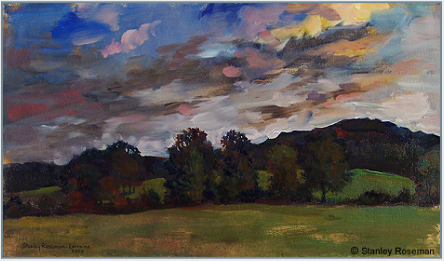
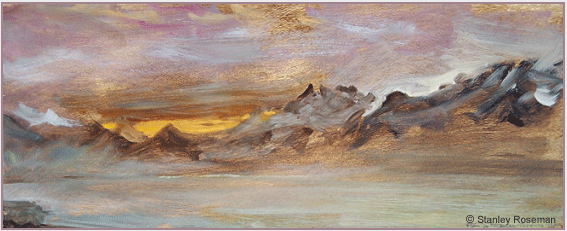
6. Two Monks Bowing in Prayer, 1979
Abbey of Solesmes, France
chalks on paper, 35 x 50 cm
National Gallery of Art, Washington, D.C.
Abbey of Solesmes, France
chalks on paper, 35 x 50 cm
National Gallery of Art, Washington, D.C.
Dom Henry, Portrait of a Benedictine Monk, 1978, (fig. 7), was painted by Roseman at St. Augustine's Abbey, Ramsgate, on the coast of Kent, where the artist began his work on the monastic life. The oil on canvas portrait is "a work of art of profound insight and spirituality,'' writes François Bergot, Chief Curator of the Museums of France, when he acquired the portrait of Dom Henry in 1986 for the Musée des Beaux-Arts, Rouen, of which he was also the Director.
13. December Morning - View from Chardonne Overlooking Lake Geneva, 1987
Oil on panel, 16 x 39.5 cm
Musée des Beaux-Arts, Rouen
Oil on panel, 16 x 39.5 cm
Musée des Beaux-Arts, Rouen
"The Saami paintings are magnificent.''
The Times, London, in a review praises Roseman's work in Lappland as "an epic project,'' and further states:
The French Benedictine Abbey of Solesmes is renowned for the study and restoration of Gregorian Chant, a reverential, musical expression associated with singing the Psalms. The year 1980 commemorated the fifteenth centenary of the birth of Benedict of Nursia (c.480 - 547), the saintly Italian abbot whose rule, known as the Rule of St. Benedict, is the basis of monastic observance in the Western Church.
The Times, London, published in 1980 a superlative, full-length page review on Roseman's work. The review features Two Monks Bowing in Prayer, 1979, Abbey of Solesmes, France, in the collection of the National Gallery of Art, Washington, D.C., (fig. 6, above). In a cordial letter to the artist, Jacques Chirac, President of France, praises the drawing as a "magnificent example of a work very successfully realized that you have consecrated to the contemplative life."
September Sunset - Pastures and Woodlands in Lorraine, (fig. 12, below), is a magnificent landscape of the French countryside. In this dramatic composition, with its distinct divisions of pictorial space, the rising, wooded hillside in the distance is sharply silhouetted against the vivid sky. The artist's detail rendering of the rows of trees and shrubs, their fall foliage subdued in the dusky light, is complemented by the freedom of brushwork in the sweeping diagonal of cloud formations illuminated by the setting sun.
"Working until the end of the day, with a cool but gentle breeze drifting over the landscape and a freshness from the surrounding greenery," writes Roseman, "I excitedly selected and blended the oil paints on my palette and applied brushstrokes of pinks, mauves, cerulean and cobalt blue, and golden ochres to the canvas to capture the wonderful spectacle of color and light in the September sky at sunset."
"Spring, summer, and fall," writes Roseman, "can be very pleasant times of the year to be at my easel or with my drawing book on a grassy hillside or in a secluded valley. But when the North Wind brings ever colder days, I willingly endure the cold for the inspiration that also comes from painting and drawing en plein air in winter.''
On an early morning in December, 1987, with distant Alpine peaks silhouetted against a golden light of dawn and a blue-gray mist ascending the hillside where Roseman stood at his easel, he painted December Morning - View from Chardonne Overlooking Lake Geneva (Matin de Décembre - Vue de Chardonne sur le Lac Léman), (fig. 13, below). The breathtaking view from the Swiss village of Chardonne, on Mont-Pèlerin, takes in a panorama of the eastern end of the great lake, the peaks of the Dents du Midi, and a range of the Savoy Alps.
A month after Roseman had painted December Morning, the Chief Curator of the Museums of France, François Bergot, acquired the landscape for the renowned collection of the Musée des Beaux-Arts, Rouen.
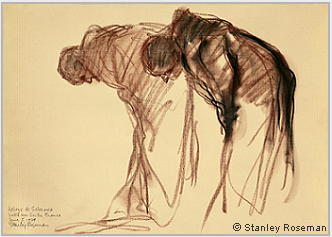

The aritist drawing the dance
from the wings of the stage
of the Paris Opéra, 1992.
from the wings of the stage
of the Paris Opéra, 1992.
The artist drawing
Trappist monks in choir,
Belgium, 1981.
Trappist monks in choir,
Belgium, 1981.
The artist sculpting a portrait of Lino, retired bricklayer, age 93,
France, 2007.
France, 2007.
Stanley Roseman,
portrait photograph,
Switzerland, 1981.
portrait photograph,
Switzerland, 1981.
The artist painting
at his easel en plein air,
France, 2014.
at his easel en plein air,
France, 2014.


